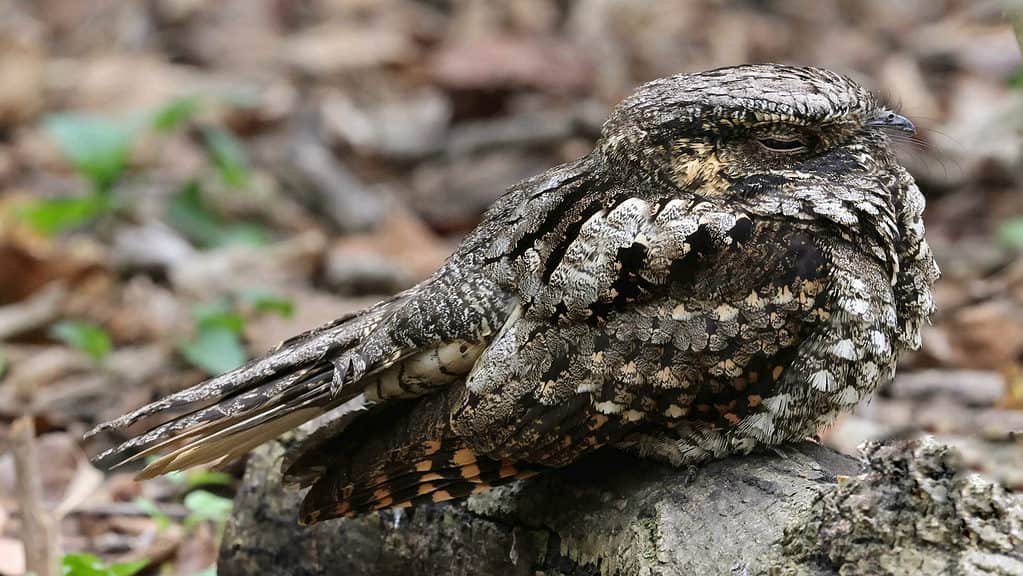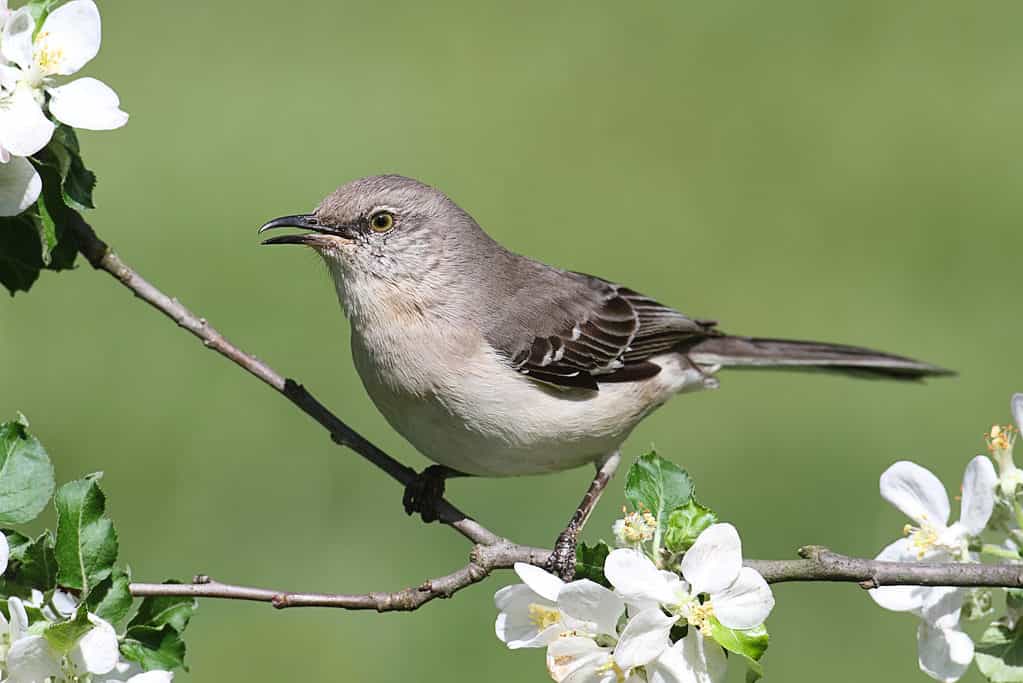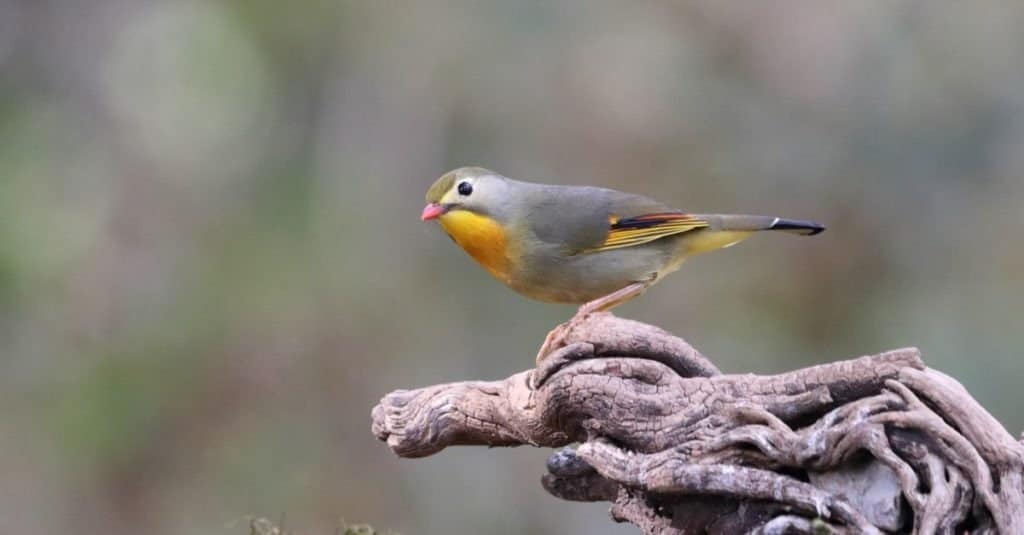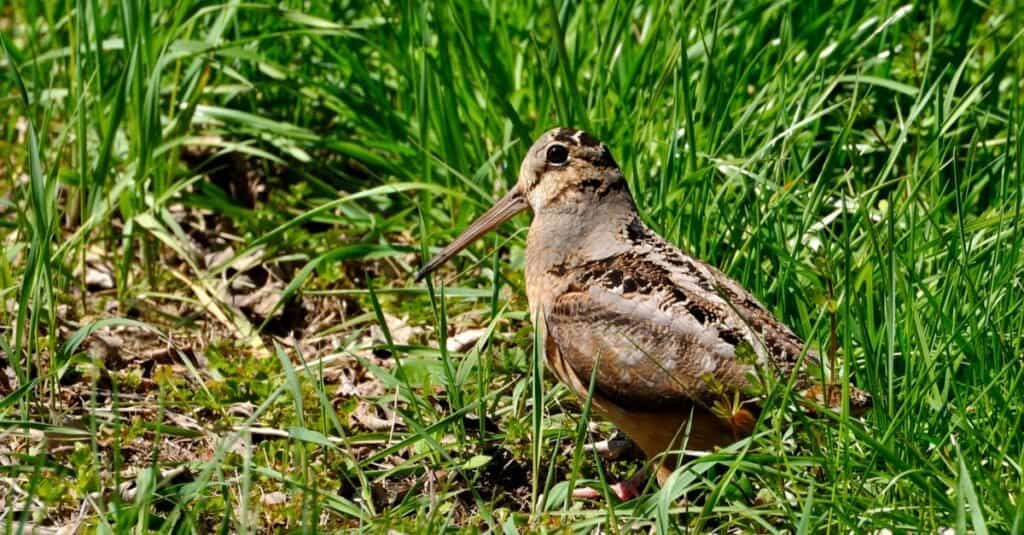The hoot of an owl in the dead of night is a common sound around the world. Owls are often synonymous with nighttime and sleepiness, but several other bird species add to the sounds and shadows of night. Discover seven other types of night birds besides owls and learn about their habitats and behaviors, including those that sing and fly under the cover of darkness.
Birds That Chirp at Night
Owls are not the only birds that make noises throughout the night. Check out these three nighttime singers.
Eastern Whip-Poor-Will

The eastern whip-poor-will (
Antrostomus vociferus) is a medium-sized nightjar from North America. They are excellent at hiding.
©iStock.com/Banu R
The whip-poor-will has inspired countless works of art for its enchanting, repeated phrase “whip-poor-will” during warm summer nights. Though not technically a songbird, these nightjars make these dreamy calls during the breeding season. Specifically, male eastern whip-poor-wills “sing” to females from their nightly perches.
You will often hear these birds before you see them. They are excellent at hiding due to their nighttime behavior and camouflaged plumage. Their feathers are mottled brown and gray, effectively concealing them among tree bark and leaf litter. You will find these night callers in the eastern half of the United States during summer before they migrate to Mexico and Central America for winter. However, some populations along the Southeastern US coast live there permanently. They breed in dry deciduous and evergreen forests near open areas, avoiding uninterrupted forests with thick canopies.
Northern Mockingbird

The northern mockingbird is known for singing well into the night (especially during a full moon) in the hopes of attracting a mate.
©Steve Byland/Shutterstock.com
Relatively drab in color, the northern mockingbird makes up for it in personality. These birds can learn up to 200 songs in their life, often mimicking other birds, frogs, car alarms, and anything else noteworthy in their environments. While they are not considered nocturnal, this species is known for singing well into the night (especially during a full moon) in the hopes of attracting a mate. They sing almost endlessly throughout the day, and unmated males are most commonly the nocturnal singers.
Northern mockingbirds live permanently across the United States and Mexico. Unlike other bird species that fluctuate between breeding and wintering grounds, mockingbirds stay in the same types of habitats year-round. You can find them in open areas with shrubby vegetation, such as parks, suburban lawns, and cultivated land. Don’t be surprised if you hear the complex songs of the northern mockingbird outside of your window long after you turn out the lights.
Nightingale

Like mockingbirds, unpaired male nightingales sing throughout the night to attract a mate. They sing in the morning to defend their territories.
©Kumar_Pankaj/Shutterstock.com
As one of the most beautiful sounds in nature, the nightingale has inspired countless works of poetry, music, and books. Their name is derived from the Old English word nihtegale, meaning “night songstress.” And sing they do, all day and night. Early writers believed the singing was from the females, but males are actually the singers, which is true for most birds. Like mockingbirds, unpaired males sing throughout the night to attract a mate. They also sing in the morning to defend their territories.
Their songs are loud and feature whistles, trills, and gurgles. And they become louder when the background noise drowns them out, especially near urban areas. They breed in Europe and Asia, migrating to Sub-Saharan Africa for the winter. Their preferred habitats include forests, shrubland, and open woodlands near water. But you will also see them in parks and suburban gardens.
Birds That Fly at Night
Did you see a shadowy figure swiftly dive from a branch? While it could be an owl, it could also be one of these four night flyers.
Yellow Warbler

The most widespread warbler species in the Americas is the yellow warbler.
©Agami Photo Agency/Shutterstock.com
The smooth, bright yellow coloring combined with the sweet, whistling songs of the yellow warbler is a mark of summer in much of North America. These birds are not nocturnal species but they are known for their nightly migrations. They breed throughout Canada and most of the United States before making their way to Mexico, Central America, and South America for the winter. They are long-distance migrants that leave their summer homes earlier than other warblers, flying across the Gulf of Mexico in a single nonstop trip.
Night migration is not uncommon in birds. They use the cover of darkness to conceal themselves from predators, stopping in the early morning to feast on insects like caterpillars and beetles. During the breeding season, they live in thickets and other disturbed habitats. But their wintering grounds consist of mangrove forests, marshes, and dry scrub.
Tawny Frogmouth

Tawny frogmouths feature cryptic plumage that allows them to take on the look and shape of a broken tree branch.
©L Twomey/Shutterstock.com
The tawny frogmouth is an unusual creature featuring cryptic plumage that allows them to take on the look and shape of a broken tree branch. These birds are nocturnal, hunting at night and sleeping during the day. Their camouflage is a necessity as they are resting during daylight hours, entirely hidden in plain sight from predators.
This species is often confused with owls but they are more closely related to nightjars. They also do not hunt like owls who actively hunt and grasp prey with their sharp talons. Frogmouths spend the night perched on low branches with their mouths gaping before snapping them shut when food comes near. The tawny frogmouth is native to the Australian mainland and Tasmania, where they inhabit parks, forests, and woodlands.
American Woodcock

American woodcocks are secretive nocturnal birds that keep a low profile, utilizing their cryptic plumage to conceal themselves during the day.
©Andrea J Smith/Shutterstock.com
Speaking of camouflage, American woodcocks are experts at blending with their surroundings. They are secretive nocturnal birds that keep a low profile, utilizing their cryptic plumage to conceal themselves during the day. They travel at night and feed and rest during daylight. You may have difficulty spotting these birds, except during dawn and dusk in the springtime.
The male’s courting behavior is one of the most fantastic sights in the natural world. Males perform evening display flights, where they travel upwards in a spiral before zig-zagging back to earth and landing next to a female. American woodcocks breed in the Northeastern United States and winter in the Southeast. They breed in young deciduous forests and old fields, performing their magnificent displays in forest clearings.
Great Potoo

Great potoo makes a haunting cry that sounds like a man moaning. Like most nocturnal creatures, the potoo bird hunts at night.
©Rob Jansen/Shutterstock.com
Great potoos are nocturnal predators most well-known for their moaning growls that haunt the neotropics at night, often startling those near their posts. They have unique features: large, round black eyes and gaping mouths. Like most nocturnal creatures, the potoo bird hunts at night and uses camouflage to sleep during the day. Their plumage and body shape resemble a tree stump during daylight hours. But at night, they perch from tall trees and sally out to catch large flying insects before returning to their perch to consume their meal. These birds have a wide distribution across Central and South America, where they live in humid forests.
The photo featured at the top of this post is © Rob Jansen/Shutterstock.com
Thank you for reading! Have some feedback for us? Contact the AZ Animals editorial team.







